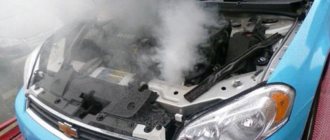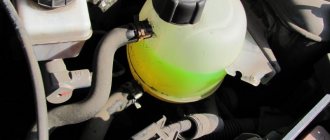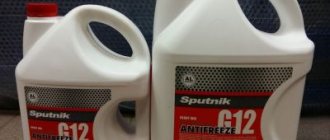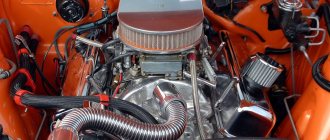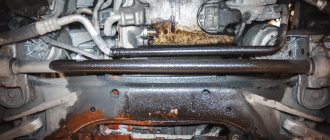Boiling antifreeze in the expansion tank in 90% of cases indicates engine overheating. If you don’t do anything, then there is a chance that you will end up with a jammed motor, the repair of which is not always advisable, and the cost of a new one will hit your pocket. So why does antifreeze boil in the expansion tank and what should you do if the temperature sensor does not indicate engine overheating?
Lack of antifreeze in the cooling system
Antifreeze, although slowly, still boils away; it has to be topped up periodically (2 - 3 times a year). Accordingly, the first step is to wait until the boiling stops, remove the cap of the expansion tank and add antifreeze (preferably the same brand as was previously used).
Some cars have 2 necks for filling antifreeze: through the expansion tank and the radiator. If the design is like this, then antifreeze is added to each of them up to the indicated marks (if there are none, then the instructions for the car contain recommendations from the manufacturer regarding the required volume of liquid in the cooling system).
Antifreeze leak
A lack of antifreeze in the system may indicate a coolant leak. In this case, after adding antifreeze, the engine can operate normally for 1–10 days, but then the problem returns again. Therefore, it would not be superfluous to conduct a detailed inspection of the pipes and connections to the expansion tank.
Leaks are often found on the radiator itself due to the appearance of cracks in it (it can only be eliminated by replacing it; it is recommended to install a copper one, although these are many times more expensive than aluminum ones).
How to choose a good antifreeze
It can be quite difficult to determine from the color and smell of a liquid whether it is good or poor quality. It is recommended not to experiment and choose brands of antifreeze that are suitable for your car model, or universal options, such as multifreeze. You need to buy a cooler only in trusted places, so as not to be afraid of encountering a low-quality fake. A properly selected fluid in a car whose systems have no malfunctions will not boil or lead to overheating or breakdown of components. The main thing is to pay attention to the compatibility tables, do not mix incompatible types and use only proven brands. SINTEC Multifreeze, compatible with all types of machines and suitable for almost all operating conditions, is a good choice.
#Trouble-shooting
Thermostat is faulty
The car's cooling system is divided into 2 parts: a small and a large circuit. Antifreeze does not enter the large circuit until it warms up to 70 - 80 degrees. Next, a special valve opens (a thermostat that responds specifically to heating) and the coolant begins to circulate through the radiator.
If the thermostat is faulty, then antifreeze circulates only through a small circuit (which is not connected to the radiator). And the cooling of the antifreeze simply does not occur (the radiator is either completely cold or slightly warm). Because of this, the cooling system does not work properly and the engine overheats immediately after starting the engine.
How to check the functionality of the thermostat? If it is technically possible to remove it, then remove it and test it by placing the valve in hot water heated to approximately 90 degrees (the thermostat should “open”). If this does not happen, then the valve has definitely failed.
In cars where the thermostat cannot be removed, it is simply knocked out (since it was initially “pressed in”). Most likely, it will be damaged, so a similar procedure should be performed after purchasing a new thermostat in advance.
Consequences of boiling coolant
Initially, the engines were cooled with water, but due to the low boiling point (100 °C°) and expansion in the cold, it was no longer used. Instead of water, they began to use special glycol liquids, the extreme boiling point of which varies from +108 °C to +125 °C.
The reason for this difference is the different composition of antifreeze. Cheap, low-quality liquids boil already at +85 °C, so saving on them is highly undesirable.
However, even temperature-resistant antifreeze can boil. There are a number of reasons for this, listed above. If you do not pay attention to this problem in time and do not solve it, the engine may fail due to constant overheating.
The degree of overheating depends on the power, weight and design of the power unit, the time between boiling and stopping the engine (the moment when it turned off and began to cool). Conditionally possible consequences can be divided into three groups - mild, moderate and severe.
If the engine overheats slightly (up to 10 minutes), slight melting of the pistons is possible. In most cases, this situation is not critical. The main thing is to notice the boiling of antifreeze in time and take action.
After 20 minutes of antifreeze boiling (medium degree of overheating), the cylinder head housing may be bent (when the engine temperature reaches +120 °C or higher), cracks may appear on the cylinder head, gasket burnout, destruction of the inter-ring partitions on the pistons, engine oil leakage through the oil seals and its mixing with boiled antifreeze.
All this may lead to the need for major engine repairs.
If for some reason the driver ignores the boiling of antifreeze and continues to operate the car, critical processes occur: melting and burning of the pistons, loss of valve seats, shaft failure, complete engine failure.
Often the car stalls and stops after the pistons break. If this does not happen, problems with the engine oil begin.
Increased pressure in the cooling system
The cooling system is closed. But when heated, the liquid expands and the internal pressure increases. In many cars, to normalize it, a check valve is installed, which dumps “excess” antifreeze into the expansion tank. At the moment when that same “reset” occurs, the antifreeze in the tank literally “gurgles,” which inexperienced drivers regard as boiling.
But if this happens too often, then this may indicate a malfunction of the reverse valve (clogged, it gets stuck). A temporary measure is to remove this valve altogether (by connecting the pipe directly to the tank). But you should still install it at the first opportunity.
Prevention
From time to time, you should prevent engine overheating in order to avoid unpleasant situations in the future. In terms of costs, this costs little money, but in the end it can save the engine from breakdown. You can identify the “weak link” by eliminating, gradually checking suspicious parts for malfunction.
In addition, overheating of the engine can occur if the wrong mode of operation of the motor is selected. For example, if you constantly drive only in lower gears and at high speeds, then the likelihood of the engine boiling increases, especially if there are deviations in the operation of the cooling system. In the cold season, some errors are not affected by low temperatures, but this does not mean that engines boil only in the summer.
Burnt through cylinder block gasket
One of the most difficult breakdowns that causes antifreeze to boil. Burning through the gasket leads to the fact that antifreeze begins to flow from the cooling system into the cylinder block, where it burns out and ends up in the exhaust system. This is often accompanied by thick white exhaust fumes. And at the same time, the level of antifreeze in the cooling system regularly drops to a minimum, although visible leaks cannot be detected.
With such a breakdown, traces of engine oil may also appear in the expansion tank - it is “sucked” from the cylinder block. After eliminating the malfunction, cleaning the cooling system is mandatory.
Repair involves disassembling the engine and replacing the damaged gasket. Naturally, this should only be done by a specialist, since it will be necessary to re-adjust the location of the valves, install the camshaft in the correct location, and so on.
What is the most common reason for gaskets to burn out? The key ones can be identified:
- natural wear and tear;
- incorrectly performed installation earlier (not tightened, threads of tightening bolts not lubricated, etc.);
- poor quality gasket;
- use of used gaskets;
- regular engine overheating.
In this situation, it is impossible to do without detailed diagnostics of the operation of motors.
Causes of malfunction
When antifreeze boils, the reasons for this phenomenon may be different. Experienced motorists are well aware of them . The most common :
- low level of coolant in the expansion tank;
- a malfunction in the thermostat;
- clogged radiator.
We recommend: Is it possible to mix antifreeze with antifreeze?
In any of these cases, the antifreeze is not able to cool quickly. His temperature is constantly rising. When this indicator reaches 120 degrees Celsius, the boiling process begins. This leads to a situation where the antifreeze begins to boil away.
Ethylene glycol is the main component of any coolant. This substance is a chemical compound that belongs to the group of alcohols. It is its presence that ensures the liquid state of the product in the cold. When it boils, the process of evaporation of ethylene glycol occurs. The main danger of this process is that the vapors of the substance are toxic and pose a serious threat to the human nervous system .
Low antifreeze level
If a car owner is faced with a problem such as antifreeze boiling on a VAZ-2114, then he first needs to check the level of technical fluid in the tank. However, this procedure should be carried out only after the antifreeze has completely cooled. If a deficiency is detected, then, depending on the situation, the following manipulations must be performed:
- If antifreeze has not been poured into the cooling system for a long time, it could simply leak out. If the level is low, it is necessary to top it up to bring the amount of technical fluid to the required level. When this is done, you can continue moving.
- In a situation where antifreeze was recently poured into the cooling system, and its level dropped to a critically low level, it is necessary to pay attention to the structural integrity of the tank. You should also inspect all pipes, as well as hoses and clamp connections for leaks of technical fluid. If a leak has been discovered, and there is no way to solve the problem right on the spot, then you need to use the service of a tow truck and drive to the nearest car service center.
If the level of antifreeze in the system is low, you cannot continue driving. Otherwise, you may encounter serious problems with the operation of the motor. Eliminating them can be costly.
Thermostat failure
As part of the cooling system, the thermostat acts as a device that regulates the temperature of the antifreeze. It is thanks to it that accelerated heating of the power unit is ensured. This device also allows you to maintain the required thermal conditions during its operation.
When the thermostat breaks down or the valve simply gets stuck in one position, the large circuit stops working. In such cases, antifreeze circulates only in a small circle. However, this does not allow it to cool completely. To determine if this part is broken, you need to turn off the engine and then open the hood. You should find the thermostat pipes and touch them carefully to avoid getting burned.
If the pipe connected to the main radiator is hotter than the others, this may indicate some kind of problem with the operation of the device. In this situation, the most reasonable solution is to travel to the nearest service station to replace the device.
Even with such a malfunction, you can continue moving further, but at low speed. In this case, every 5 km you should stop and perform the procedure of adding water to the expansion tank. But this operation can be carried out only after the power unit has cooled. Then you can easily get to the service center and replace the faulty device.
Radiator problems
Antifreeze boiling can also occur if the radiator stops working. This malfunction may occur in the following cases:
- During operation, a layer of scale may appear on the tubes of the product. This leads to the fact that their thermal conductivity is noticeably reduced. When the number of clogged pipes increases, the ability of the radiator to cool the antifreeze passing through it decreases.
- There is dirt in the radiator or the tubes are completely clogged. If such a problem occurs, it leads to a decrease in coolant circulation. In advanced cases, this process stops altogether. As a result, the temperature of the antifreeze increases - it boils.
- A problem with the radiator can also arise if the fan fails. Then the product does not have the ability to cool the antifreeze to the required temperature. The car owner can independently determine that the malfunction occurred in the fan. This can be done by ear. If the car engine is quiet when starting, it means it is not turned on.
In any of these cases, you can continue moving, but there is one caveat. It is necessary to stop every 8 km to allow the engine to cool down. Otherwise, problems with the engine cannot be avoided.
Pump faulty
The circulation of the coolant is ensured by a circulating pump (pump), which is driven either by a belt drive or by an electric motor. If the pump stops pumping antifreeze, then it simply will not have time to cool, flowing through the radiator. As a rule, with such a breakdown, the “Check” signal lights up on the dashboard. Repair - replacing the pump with a new one.
In engines where the pump is driven by a belt drive (found mainly in older cars), you should also check that the belt is not slipping. This can occur due to the ingress of oil, antifreeze, or water (in rainy weather).
Fan doesn't work
The fan is installed behind the radiator and creates a powerful air flow, which cools the coolant flowing through it. If it is faulty or does not turn on (because the temperature sensor has failed), then the radiator will not be ventilated enough, and accordingly, the engine temperature, although slowly, will rise to a critical level of over 110 degrees. This happens mainly in the warm season, since in winter and without a fan the radiator will cool normally at average engine loads.
Repair - either replacing the fan or temperature sensor. As a temporary measure, you can consider removing the temperature sensor and connecting the impeller directly to 12V (to the battery). In this case, it will work continuously without turning off (only when the ignition is on).
Air blockage
If air gets into the cooling system, a pneumatic plug is formed, due to which antifreeze simply does not circulate through the radiator. Mostly this occurs when small holes appear in the pipes or in the radiator itself (air is “sucked in” through them). In this case, antifreeze almost immediately boils in the expansion tank after starting the engine.
Repair involves eliminating the hole; the easiest way to find it is through a thorough inspection of the cooling system with the engine running. It is necessary to find exactly where the liquid is leaking.
Preventive measures
To avoid cooling system malfunctions, you need to buy high-quality antifreeze from trusted auto stores and services. If everything worked before replacing the antifreeze, but after the replacement the system boiled, most likely the reason was poor-quality antifreeze.
A sign of fake antifreeze is its boiling over at a temperature on the dashboard of 90 °C. In this case, if the VAZ 2114 boils at 90 degrees, a complete drain of the fake and flushing of the entire cooling system is required.
When purchasing antifreeze, you need to pay attention to both the boiling point and boiling pressure. If the pressure does not match atmospheric pressure, recalculate the temperature. For example, at the promised 135°C-1.2 atm. antifreeze will boil at 100°C-1 atm (if the atmospheric pressure is normal, it will boil at 100°C).
During a daily inspection of the engine compartment with the engine running, you can detect fluid leaks, ruptures in connecting pipes and contamination of the radiator.
To prevent the engine from overheating, you need to set the fan activation temperature on the on-board computer to 95°C (change from the factory setting to 102-105°C).
Low ambient pressure
You may encounter something similar while traveling. The fact is that the higher the car is above sea level, the lower the boiling point of the coolant. These are the simplest laws of physics, known from school.
If at an altitude of 0 meters above sea level the boiling temperature is in the range of 100 - 110 degrees, then at an altitude of 2.5 - 3 km antifreeze will begin to boil at 85 - 90 degrees. But the engine should not overheat. This is not a breakdown, but a natural behavior of the coolant.
